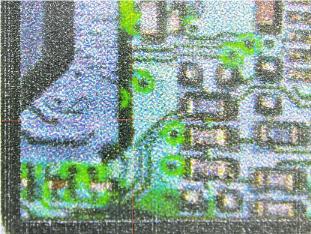Paper ink colour observation: microscope opens up microscopic exploration
In many areas of today's printing, packaging and artistic creation, the precise rendering and control of paper and ink colours is crucial. From fine book printing to high-end packaging design, colour accuracy has a direct impact on the visual effect and quality of the product. In order to understand the mystery of paper ink colour, scientists and professionals have embarked on a journey of microscopic exploration, and the microscope has become a powerful tool in their hands.


Traditional paper ink colour observation relies on visual observation and empirical judgment, but this approach has great limitations. The human eye has limited resolution, and it is difficult to detect the subtle differences in ink colour at the microscopic level, and the distribution and morphology of pigment particles. With the industry's increasing demand for colour accuracy, more accurate and in-depth observation means are urgently needed.
Against this background, motorised zoom autofocus microscopes stand out with their unique advantages. POMEAS motorised zoom autofocus microscopes offer fast and accurate zoom. Compared with traditional manual zoom microscopes, operators do not need to manually adjust complicated knobs, and can switch between different magnifications in a short period of time by simple push-button operation, which greatly improves observation efficiency. Its auto-focus function is a highlight, which can lock a clear image in an instant, avoiding the blurring of the image and the waste of time caused by manual focusing, and providing great convenience for the observation of paper and ink colours.


0.7X
When the microscope is applied to colour observation of paper inks, it is useful beyond imagination. In the microscopic view, the pigment particles in the ink are clearly visible. Through the microscope, we can observe the size, shape and distribution of pigment particles. The different characteristics of the pigment particles have a direct influence on the colour performance of the ink.


4.5X
At the same time, microscopy helps us to study the interaction between paper and ink. The fibre structure of paper has an important influence on the absorption and adhesion of ink. Through the microscope observation, you can clearly see the penetration of ink between the fibres of the paper, thus providing a strong basis for adjusting the printing process and optimizing the ink formula. In the printing process, if the ink is found in some paper drying speed is too fast or too slow, through the microscope to observe the paper fibre and ink combination state, you can find out where the problem lies, and targeted for improvement.
In addition, in the field of art restoration and identification, the microscope on the paper ink colour observation also plays a key role. Ancient books, paintings, paper and ink with the passage of time will occur aging, fading and other changes. Using microscopes, experts can deeply analyse the process of ink colour change, understand the change of its chemical composition, so as to formulate a scientific and reasonable restoration plan, and restore the original appearance of the artwork to the maximum extent.
The microscope opens the door to the microscopic world of paper ink colour observation. POMEAS' motorised zoom autofocus microscopes have become the ideal tool for microscopic exploration in the industry due to their excellent performance. With the help of microscopes, we have gained a deeper and more comprehensive understanding of paper ink colours, which not only promotes technological advances in the printing and packaging industries, but also provides strong support in areas such as cultural heritage preservation.
Product recommendation
TECHNICAL SOLUTION
MORE+You may also be interested in the following information
FREE CONSULTING SERVICE
Let’s help you to find the right solution for your project!


 ASK POMEAS
ASK POMEAS  PRICE INQUIRY
PRICE INQUIRY  REQUEST DEMO/TEST
REQUEST DEMO/TEST  FREE TRIAL UNIT
FREE TRIAL UNIT  ACCURATE SELECTION
ACCURATE SELECTION  ADDRESS
ADDRESS Tel:+ 86-0769-2266 0867
Tel:+ 86-0769-2266 0867 Fax:+ 86-0769-2266 0867
Fax:+ 86-0769-2266 0867 E-mail:marketing@pomeas.com
E-mail:marketing@pomeas.com
